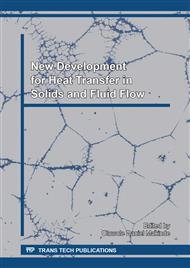[1]
G.B. Jeffery, The two-dimensional steady motion of a viscous fluid, Phil. Mag., 6 (1915) 455-46.
Google Scholar
[2]
G. Hamel, Spiralförmige Bewgungen Zäher Flüssigkeiten, Jahresbericht der Deutschen Math. Vereinigung, 25 (1916) 34-60.
Google Scholar
[3]
L. Rosenhead, The steady two-dimensional radial flow of viscous fluid between two inclined plane walls, Proc. R. Soc. A, 175 (1940) 436-467.
DOI: 10.1098/rspa.1940.0068
Google Scholar
[4]
G. K. Batchelor, An Introduction to Fluid Dynamics, Cambridge University Press: Cambridge, (1967).
Google Scholar
[5]
R. Sadri, Channel entrance flow, Ph.D. thesis, Dept. Mechanical Engineering, University of Western Ontario, (1997).
Google Scholar
[6]
M. Hamadiche, J. Scott, D. Jeandel, Temporal stability of Jeffery-Hamel flow, J. Fluid Mech., 268 (1994) 71-88.
DOI: 10.1017/s0022112094001266
Google Scholar
[7]
L. E. Fraenkel, Laminar flow in symmetrical channels with slightly curved walls. I: On the Jeffery-Hamel solutions for flow between plane walls, Proc. R. Soc. London, 267 (1962) 119 - 138.
DOI: 10.1098/rspa.1962.0087
Google Scholar
[8]
I. J. Sobey, P. G. Drazin, Bifurcations of two-dimensional channel flows, J. Fluid Mech., 171 (1986) 263-287.
DOI: 10.1017/s0022112086001441
Google Scholar
[9]
O. D. Makinde, Steady flow in a linearly diverging asymmetrical channel, Comp. Assist. Mech. and Eng. Sci., 4 (1997) 157 - 165.
Google Scholar
[10]
O. D. Makinde, P. Y. Mhone, Hermite-Pade' Approximation approach to Hydromagnetic flows in convergent-divergent channels, Appl. Math. and Comp., 181(2) (2006) 966 - 972.
DOI: 10.1016/j.amc.2006.02.018
Google Scholar
[11]
O. D. Makinde, P. Y. Mhone, Temporal stability of small disturbances in MHD Jeffery-Hamel flows, Comp. & Math. with Appl., 53 (2007) 128 - 136.
DOI: 10.1016/j.camwa.2006.06.014
Google Scholar
[12]
O. D. Makinde, Effect of arbitrary magnetic Reynolds number on MHD flows in convergent-divergent channels, Int. J. of Num. Meth. for Heat & Fluid Flow, 18(6) (2008) 697 - 707.
DOI: 10.1108/09615530810885524
Google Scholar
[13]
S. U. S. Choi, Enhancing thermal conductivity of fluids with nanoparticles, In Proceedings of the 1995 ASME Int. Mech. Eng. Cong. and Exposition, 66, San Francisco, USA, (1995) 99-105.
Google Scholar
[14]
M. Sheikholeslami, D. D. Ganji, H. R. Ashorynejad, H. B. Rokni, Analytical investigation of Jeffery-Hamel flow with high magnetic field and nanoparticle by Adomian decomposition method, Appl. Math. Mech. Engl. Ed, 33 (2012) 25-36.
DOI: 10.1007/s10483-012-1531-7
Google Scholar
[15]
A. Moradi, A. Alsaedi, T. Hayat, Investigation of heat transfer and viscous dissipation effects on the Jeffery-Hamel flow of nanofluids, Thermal Sci., 19(2) (2015) 563-578.
DOI: 10.2298/tsci120410208m
Google Scholar
[16]
G. S. Seth, M. K. Singh, Combined free and forced convection MHD flow in a rotating channel with perfectly conducting wall, Ind. J. Theo. Phys., 56 (2008) 203-222.
Google Scholar
[17]
T. M. Syed, U. Khan, N. Ahmed, W. Sikander, A study of Velocity and Temperature slip effects on flow of water based nanofluids in Converging and Diverging Channels, Int. J. Appl. Comp. Math, (2015) DOI 10. 1007/s40819-015-0032-z.
DOI: 10.1007/s40819-015-0032-z
Google Scholar
[18]
A. Bejan, Entropy-generation minimization, CRC Press, New York, (1996).
Google Scholar
[19]
A. Bejan, A study of entropy generation in fundamental convective heat transfer, J. Heat Trans., 101 (1979) 718-725.
DOI: 10.1115/1.3451063
Google Scholar
[20]
S. Das, S. Chakraborty, R. N. Jana, O. D. Makinde, Entropy analysis of unsteady magneto-nanofluid flow past accelerating stretching sheet with convective boundary condition, Appl. Math. and Mech., 36(12) (2005) 1593-1610.
DOI: 10.1007/s10483-015-2003-6
Google Scholar
[21]
H. Padé, Sur la représentation approchée d'une fonction pour des fractions rationnelles, Ann. Sci. École Norm. Sup. Suppl., 9 (1892) 1-93.
DOI: 10.24033/asens.378
Google Scholar
[22]
C. Hermite, Sur la généralisation des fractions continues algébriques, Annali. di. Math. Pura e Applicata, 21(2) (1893) 289-308.
DOI: 10.1007/bf02420446
Google Scholar
[23]
P.G. Drazin, Y. Tourigny, Numerically study of bifurcation by analytic continuation of a function defined by a power series, SIAM J. of Appl. Math., 56 (1996) 1-18.
DOI: 10.1137/s0036139994272436
Google Scholar
[24]
M.A.H. Khan, High-Order Differential Approximants, J. of Comp. and Appl. Math., 149 (2002) 457-468.
Google Scholar
[25]
M. M. Rahman, A New Approach to Partial Differential Approximants, M. Phil, Bangladesh University of Engineering & Technology, Dhaka, (2004).
Google Scholar
[26]
L.C. Woods, Thermodynamics of Fluid Systems, Oxford University Press, Oxford, UK, (1975).
Google Scholar


